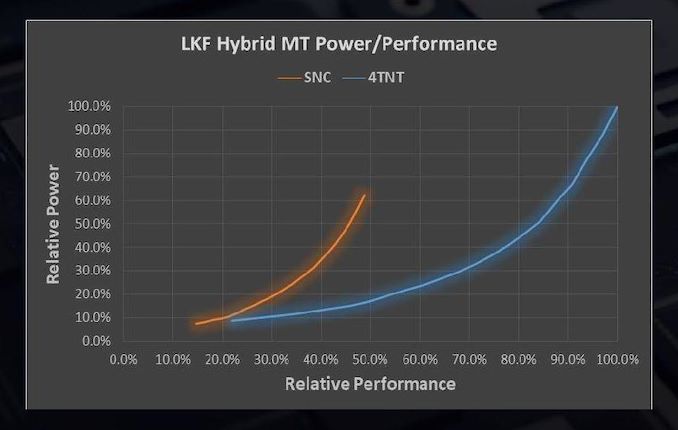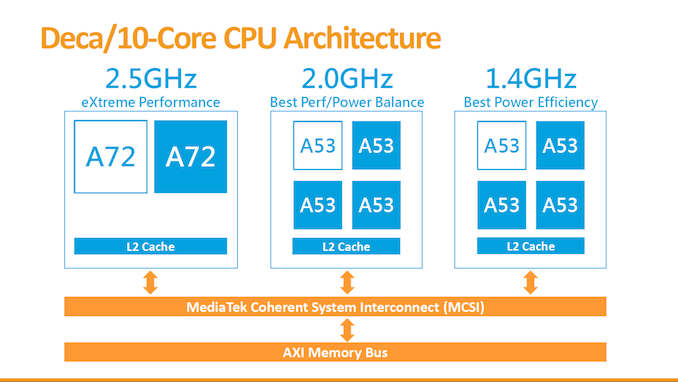The Intel Lakefield Deep Dive: Everything To Know About the First x86 Hybrid CPU
by Dr. Ian Cutress on July 2, 2020 9:00 AM ESTHow To Treat a 1+4 Hybrid CPU
At the top of the article, I explained that the reason for using two different types of processor core, one big on performance and the other big on efficiency, was that users could get the best of both worlds depending on if a workload could be run efficiently in the background, or needed the high performance for a user experience interaction. You may have caught onto the fact that I also stated that because Intel is using a 1+4 design, it actually makes more sense for multi-threaded workloads to run on the four Atom cores.
Using a similar power/performance graphs, the effect of having a 1+4 design is quite substantial. On the left is the single core power/performance graphs, but on the right is when we compare 1 Sunny Cove to all 4 Tremont cores working together.
Where the previous graph considered a 1+1 design, which is more relevant in those user experience scenarios listed above, on the right is the 1+4 design for when the user demands a heavier workload that might not be latency critical. Because there are four Atom cores, the blue line multiplies by four in both directions.
Now obviously the real world scenario is somewhere between the two, as it is possible to use only one, two, or three of the smaller cores at any given time. The CPU and the OS is expected to know this, so it can govern when workloads that can be split across multiple cores end up on either the big core or the small core.
In this graph from Intel, we have three distinct modes on which threads can operate.
- ‘Sunny Cove/SNC’ is for responsiveness and user experience threads,
- ‘Tremont/TNT Foreground’, for user related tasks that require multiple threads that the user is waiting on.
- ‘Tremont/TNT Background’, for non-user related tasks run in efficiency mode
Even though the example here is web browsing, it might be best to consider something a bit beefier, like video encoding.
If we run video encoding, because it is a user related task that requires multiple threads, it will run on the four Tremont cores (TNT FG). Anything that Windows wants to do alongside that gets scheduled as TNT BG. If we then open up the start menu, because that is a responsiveness task, that gets scheduled on the SNC core.
Is 1+4 the Correct Configuration?
Intel here has implemented a 1+4 core design, however in the smartphone space, things are seen a little differently. The most popular configuration, by far, is a 4+4 design, simply because a lot of smartphone code is written to take advantage of multiple foreground or multiple background threads. There are a number of cost-down designs that reduce die area and power by going for a 2+4 implementation. Everyone seems adamant that 4 is a good number for the smaller cores, partly because they are small and cheap to add, but because Arm’s quad-core implementation is a base unit for its IP.
The smartphone space in recent quarters has also evolved from a two tier system of cores. In some of the more leading edge designs, we now have three types of core: a big, a middle, and a small. Because of the tendency to stay with eight core designs, we now get 1+3+4 or 2+2+4 designs, powered by complex schedulers that manage where to put the threads for the best user experience, the best battery life, or somewhere in the middle. Mediatek has been famously dabbling in 10 core designs, going for a 2+4+4 approach.
One thing missing from all of these implementations is an SoC with one big core and four small cores. Smartphone vendors don’t seem to be interested in 1+4 silicon, and yet Intel has decided on it for Lakefield. This is borne out of decisions made on both sides.
From the smartphone perspective, when hybrid designs came about, the big cores just weren’t powerful enough on their own. In order to offer something more than simply basic, at least two cores were needed, but because of how Arm architected the big and little designs, it almost became standard to look into 4+4 implementations of big and small cores. It was only until this configuration was popularized over a couple of years, and Arm big cores got more powerful, that chip designs started looking at 2+4, or 1+3+4 designs.
On Intel’s side of the fence, the biggest problem it has is the size of the Sunny Cove core. By comparison, it’s really, really big. Because the graphics core is the same as Ice Lake and reuses its design, there simply isn’t enough room within the 82 mm2 compute die to add another core. Not only that, but there is a question of power. Sunny Cove wasn’t built for sub-1W operation, even in the Tremont design. We see big smartphone silicon pulling 4-5W when all eight cores are active – there is no way, based on our understanding of Intel’s designs, that we could see four (or even two) Sunny Cove cores being in the optimal performance per watt range while being that low. Intel’s Lakefield graphics, with 64 EUs, is running at only 500 MHz – a lot lower than the Ice Lake designs. Even if Intel moved that down to a 32 EU design to make space for another Sunny Cove core, I reckon that it would eat the power budget for breakfast and then some.
Intel has made the 1+4 design to act as a 0+4 design that sometimes has access to a higher performance mode. Whereas smartphone chips are designed for all eight cores to power on for sustained periods, Lakefield is built only for 0+4 sustained workloads. And that might ultimately be its downfall. This leads onto a deep discussion about Lakefield’s performance, and what we should expect from it.














221 Comments
View All Comments
extide - Thursday, July 2, 2020 - link
That's basically what the latter generation Xeon Phi was.JorgeE1 - Thursday, July 2, 2020 - link
Intel can name the manufacturing process: Ferveros Ultra paCKed Scalar Hybrid Intel sTacked Silicon69369369 - Thursday, July 2, 2020 - link
EDGYD
G
Y
serendip - Thursday, July 2, 2020 - link
"But the bottom line is that in most cases, expect Lakefield to perform similar to four Atom cores, just above Goldmont Plus, and not like any of the Skylake/Ice Lake Core products and its derivatives."So a Kaby Lake Pentium will outperform this with 2 less cores and similar TDP while being a lot cheaper. That big core is sitting around doing nothing. It should be used as a turbo boost core, much like how the m3-8100Y behaves in the Surface Go 2.
Intel is either ballsy or stupid to pit this against the SD 8CX in the same price range.
lmcd - Thursday, July 2, 2020 - link
That TDP is at its pitiful base clocks. Tremont will outperform Sunny Cove and Skylake both at the lower power designations a second core is allowed, while using less die space. The second core in a Kaby Lake Pentium is worth less than the Tremont core in a theoretical 1+1 Lakefield design because the second core is throttled to around that 60% mark in the perf/watt curve graphic in the first place.Jorgp2 - Thursday, July 2, 2020 - link
Atom does support GFNIquorm - Thursday, July 2, 2020 - link
I don't know. The tech is interesting, especially the stacking, but overall, this doesn't seem to offer much benefit. Judging from the provided graphs, the power consumption difference between core and atom is too small to justify it. Does atom have dedicated hardware decode for current video codecs? Only way I could see this being beneficial, at least in this first iteration.brucethemoose - Thursday, July 2, 2020 - link
Even pure Atom SoCs had hardware decoding, right? IDK where it is on the die, but thats traditionally "part" of the GPU, and stuff like Netflix won't even run without it.lmcd - Thursday, July 2, 2020 - link
Yea that's 100% part of the die and it's why stuff like Silvermont getting upgraded Intel graphics as opposed to earlier bad PowerVR graphics (and weak decode blocks) was absolutely essentialalufan - Thursday, July 2, 2020 - link
hmm intel glueing cpus together then?Pity they are both sows ears and cant be polished